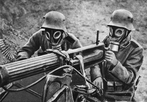
Back Актәи адунеизегьтәи аибашьра Abkhazian Eerste Wêreldoorlog Afrikaans Erster Weltkrieg ALS የመጀመሪያው የዓለም ጦርነት Amharic Primera Guerra Mundial AN Fyrst Woruldgūþ ANG الحرب العالمية الأولى Arabic لحرب لعالمية لولة ARY الحرب العالميه الاولانيه ARZ প্ৰথম বিশ্বযুদ্ধ Assamese
| World War I | |||||||||
|---|---|---|---|---|---|---|---|---|---|
| |||||||||
| |||||||||
| Belligerents | |||||||||
Allied Powers:
|
Central Powers:
| ||||||||
| Commanders and leaders | |||||||||
| See Main Allied leaders | See Main Central leaders | ||||||||
| Casualties and losses | |||||||||
|
| ||||||||
World War I[b] or the First World War (28 July 1914 – 11 November 1918), also known as the Great War, was a global conflict between two coalitions: the Allies (or Entente) and the Central Powers. Fighting took place mainly in Europe and the Middle East, as well as in parts of Africa and the Asia-Pacific, and in Europe was characterised by trench warfare and the use of artillery, machine guns, and chemical weapons (gas). World War I was one of the deadliest conflicts in history, resulting in an estimated 9 million military dead and 23 million wounded, plus up to 8 million civilian deaths from causes including genocide. The movement of large numbers of people was a major factor in the Spanish flu pandemic, which killed millions.
The causes of World War I included the rise of Germany and decline of the Ottoman Empire, which disturbed the long-standing balance of power in Europe, as well as economic competition between nations triggered by industrialisation and imperialism. Growing tensions between the great powers and in the Balkans reached a breaking point on 28 June 1914, when a Bosnian Serb named Gavrilo Princip assassinated Archduke Franz Ferdinand, heir to the Austro-Hungarian throne. Austria-Hungary held Serbia responsible, and declared war on 28 July. After Russia mobilised in Serbia's defence, Germany declared war on Russia; by 4 August, France and the United Kingdom were drawn in, with the Ottomans joining in November. Germany's strategy in 1914 was to quickly defeat France, then to transfer its forces to the east. However, this failed, and by the end of the year the Western Front consisted of a continuous line of trenches stretching from the English Channel to Switzerland. The Eastern Front was more dynamic, but neither side gained a decisive advantage, despite costly offensives. Italy, Bulgaria, Romania, Greece and others joined in from 1915 onward.
In April 1917, the United States entered the war on the Allied side following Germany's resumption of unrestricted submarine warfare against Atlantic shipping. Later that year, the Bolsheviks seized power in the Russian October Revolution; Soviet Russia signed an armistice with the Central Powers in December, followed by a separate peace in March 1918. That month, Germany launched an offensive in the west, which despite initial successes left the German Army exhausted and demoralised. A successful Allied counter-offensive from August 1918 caused a collapse of the German front line. By early November, Bulgaria, the Ottoman Empire and Austria-Hungary had each signed armistices with the Allies, leaving Germany isolated. Facing a revolution at home, Kaiser Wilhelm II abdicated on 9 November, and the war ended with the Armistice of 11 November 1918.
The Paris Peace Conference of 1919–1920 imposed settlements on the defeated powers, most notably the Treaty of Versailles, by which Germany lost significant territories, was disarmed, and was required to pay large war reparations to the Allies. The dissolution of the Russian, German, Austro-Hungarian, and Ottoman Empires redrew national boundaries and resulted in the creation of new independent states, including Poland, Finland, the Baltic states, Czechoslovakia, and Yugoslavia. The League of Nations was established to maintain world peace, but its failure to manage instability during the interwar period contributed to the outbreak of World War II in 1939.
Cite error: There are <ref group=lower-alpha> tags or {{efn}} templates on this page, but the references will not show without a {{reflist|group=lower-alpha}} template or {{notelist}} template (see the help page).





